Class News
Yale remembers Selma, then and now
YaleNews article, March 6, 2015
Saturday, March 7, 2015 marks the 50th anniversary of the first of three planned Selma-to-Montgomery marches promoting the Voting Rights Movement in Alabama. The first march — organized by the Reverend Martin Luther King Jr. and activists from the Southern Christian Leadership Conference — became known as “Bloody Sunday” after state troopers attacked the unarmed marchers with billy clubs and tear gas at the Edmund Pettus Bridge just outside of Selma.
In the wake of “Bloody Sunday,” scores of Yale students and faculty headed south to take part in the subsequent Selma-to-Montgomery marches on March 9 and 21. These included Jonathan Steele ’65 M.A. and Gordon Wilcox ’65, who offer the following accounts of their experiences — the former written shortly after the second march in 1965, the latter looking back 50 years later.
Members of the Class of 1964, Steve Bingham and Joe Lieberman, are mentioned at the end of this article.
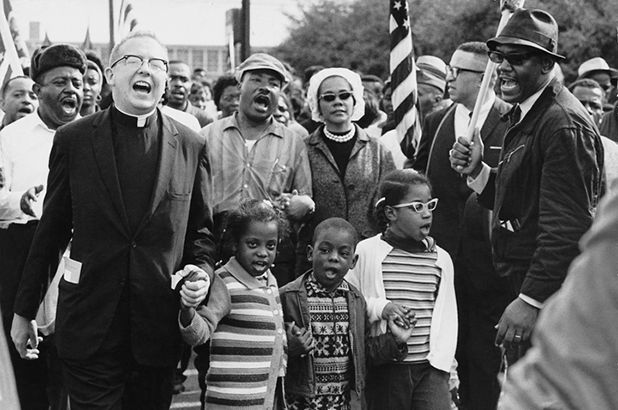
Civil Rights Movement co-founder the Reverend Ralph David Abernathy (background, far left) walks with the Reverend Martin Luther King Jr. and Coretta King. The Abernathy children march on the front line, leading the Selma-to-Montgomery March in 1965. (Courtesy Abernathy Family Photos)
In Selma, Alabama (1965)
Jonathan Steele ’65 M.A. has had a distinguished career as an author and a journalist with the Guardian. He was an active participant in the civil-rights movement during his time at Yale and wrote about the events of Selma for the Manchester Guardian Weekly in the U.K. on March 18, 1965. The following, published with the author’s permission, is his article, as it originally appeared.
Selma, Alabama, is a community that is on fire. For two months the focus of its life has been two buildings and two men; down in the centre of town stands the grey stone pile of the Dallas county courthouse and in it is the office of Sheriff James G. Clark, a man who has become the symbol and spokesman of most of white Selma. A mile away in a Negro section of town, that is so surrounded by Alabama State Troopers as to be almost inaccessible, is the twin-towered red-brick Brown’s Chapel; all the marches that Dr. Martin Luther King has led have begun from here; but even when Dr King is not present this church is the heart of the Negro community.
People are in and out of the church all the time. Meetings are called at any hour of the day and are always well attended. Many of the women are in the basement of the church cooking food for the demonstrators. Negro Sunday services are traditionally followed by a feast on the porch of the church, but now it is simply a question of feeding the many out-of-State volunteers. Some of the women have given up their jobs in white homes to remain in the community. Many of the men, too, are on strike. They stand in groups on the street or are sitting in the demonstrations. Some are farmers from neighbouring counties where there have also been marches but who have been drawn in now by the magnet of the Selma spirit and are staying with relations in town.
The high school students themselves stand often on the wide front steps of the church and lead the “freedom singing.” “Ain’t going to let nobody turn me round, turn me round,” or “We shall not, we shall not be moved, just like a tree that’s standing by the water, we shall not be moved.” They have even developed a special litany, “What do you want?” “Freedom.” “No, no, what do you really want?” “Freedom.” “When do you want it?” “Now.” Most of the high school students have not been to school for seven weeks.
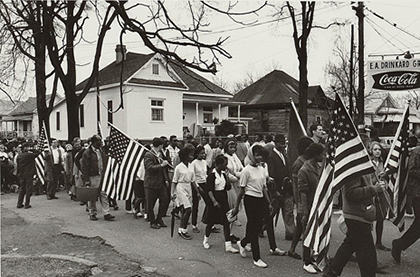
Participants, some carrying American flags, marching in the civil-
rights march from Selma to Montgomery, Alabama in 1965.
(Photo by Peter Pettus)
It is always relatively easy to get the young people interested in the movement. They held the Mississippi project together last summer, spending the mornings in the freedom schools, and canvassing in the afternoon. But to involve their parents’ generation is much harder. The great success of Selma has been the ability of Martin Luther King’s more religiously oriented Southern Christian Leadership Conference (SCLC) to draw in and unite all age groups in the community. His approach is different than that of the Student Non-Violent Co-ordinating Committee (SNCC) which with its more political, more secular, and more militant appeal shows a narrow base of operation by trying to bypass the tight grip that the Negro Church has on the people in the South.
SNCC is operating in Selma; it was this organisation which began the first voter registration drive here in 1962, but for the moment it has had to concede the leadership to Dr King’s SCLC in a temporary coalition. Which group will be most useful in the long run, no one can say — that is if a real alliance of the two is impossible.
High morale
Be that as it may, the solidarity of the Selma community during the two-month period of the demonstrations has been astounding. The only possible parallel may be the Montgomery bus boycott of 1956, the movement that first put Dr King in the national limelight. And now the influx of out-of-state volunteers, ministers, doctors, and students, have raised morale in Selma to a new high. The volunteers have swelled the ranks of the demonstrators who have been sitting out in the street for days and nights now, facing the state troopers.
The chapel inside looks like a refugee camp; white ministers with several days’ growth of beard are stretched out, sleeping on the wooden pews; a group of students huddled in a corner is plucking softly at a guitar; the whole community is sleeping in shifts, taking turns out in the street with the demonstrators. The state troopers are almost a joke now, as they stand bleary-eyed in a blue uniformed line across the street, or take a minute off behind the line to lean on the windows of their coffee and doughnut truck.
The high school students have improvised a verse for them in their song “Everybody wants freedom, Alabama wants freedom, state troopers want freedom.” Or in the song that they have written: “State troopers are a Berlin wall … in Selma, Alabama. Hate is the thing that laid that wall … in Selma, Alabama. Love is the thing that will make it fall … in Selma, Alabama.”
For most of the white ministers who came down here, to say that the situation was unbelievable is an understatement. The feeling of concern over Selma had been simmering throughout the nation for a month and a half. On Monday last week, with the publication of the pictures of state troopers’ brutal attack on the Negro marchers, it boiled over. There followed Martin Luther King’s sudden appeal for people to come down, the hasty decisions, the rushed goodbyes, and a dash to the airport. None of us knew how many were going. Were we the only group of five or ten? Could we make any difference?
At Kennedy Airport in New York at 11:30 on Monday night we began to get an answer as the planes were filled with a disproportionate number of ministers. Two hours later Atlanta Airport was like a religious convention. From Cleveland, Detroit, Philadelphia, and Washington the planes arrived. We felt that we were watching the whole conscience of a nation visibly come to life. Almost every hire car in Atlanta must soon have been rented, and three hours later we had reached Montgomery, Alabama, and were leaving town on the 45-mile stretch of road to Selma. By eleven o’clock on Tuesday morning most of us had arrived and been immediately swept up into the spirit of the Selma community.
The leaders of SCLC spoke to us in the church. They told about the injunction against the march but said they felt that it had to be defied. “Injunction or no injunction, we’re going to march. Ever since I was born a Negro I’ve had an injunction against me.”
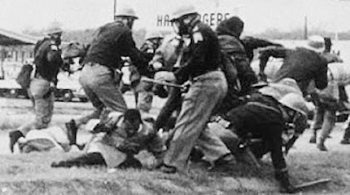
Alabama state troopers attack marcher John Lewis
at the Edmund Pettis Bridge.
A doctor from the Medical Council of Human Rights raised a nervous tension-relieving laugh with his unintentional warning, “If you are struck on the head, whether you are conscious or unconscious, get in touch with one of us.” Finally there was Martin Luther King, “I would rather die today on the highways of Alabama than make a butchery of my own conscience.” In a few seconds what he called “the greatest single moment of the nonviolent movement” was upon us as he led the march through the church doors. Three thousand people, including a thousand ministers of all faiths and the wives of two Senators, walked slowly down the dusty Alabama street.
Few jeers
The jeers from bystanders were conspicuously few. Never before had white ministers in such numbers participated in a march in the South. The faces of the troopers, massed along the road holding their sticks, were similarly consumed, as we began to walk past them now across the bridge, over the muddy yellow waters of the Alabama River and out of the city limits of Selma. Within 10 minutes we had been stopped. After a short prayer and the singing of “We shall overcome,” we were walking back into town. A Negro girl beside me was crying softly. Others were bitter and angry, others sang “I love everybody in my heart. I love George Wallace in my heart.” What did it mean? Should we have turned back? Should we rather have sat down in the road? Had we been betrayed?
Back in the church, the Rev. James Bevill, of the SCLC, had the answer: “Some people think that because we were so many, because we had so many ministers and out-of-State people, we should have tried to go through the troopers. You see, that’s what we understand in America. If you’re big and strong, you trample on little people. But the thing with nonviolence is this — you must act alone, even if you are with a million people, or two million, you must act as if you are alone. We just testify. We don’t force anybody. We don’t intimidate anybody. We just testify.”
Even now in that street in Selma the testimony of the day and night vigil is still going on. “Love is the thing that will heal us all…in Selma, Alabama.”
In Selma, Alabama (2015)
Gordon Wilcox ’65 offers his reminiscences on campus participation with the Selma marches and the civil rights movement. Wilcox, who is now an attorney, was the chair of the Yale Civil Rights Council at the time.
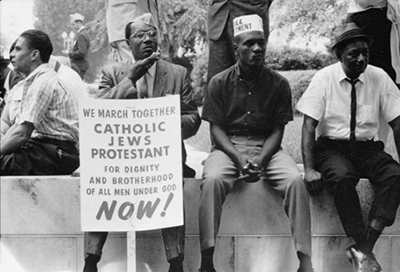
Participants in the civil rights march rest for a moment.
(Photo by Peter Pettus)
We started the council after 63 students had gone to Mississippi in October 1963, encouraged by William Sloane Coffin Jr. ’49, ’54 B.D., an original “Freedom Rider” in 1961; Allard Lowenstein ’54 J.D.; and Joe Lieberman ’64, ’67 J.D. Some of those students had also participated in the 1964 “Freedom Summer” in Mississippi. Although an FBI report at the time of the second Selma march said there was no organized travel south by Yale students, nine of us left within a day after “Bloody Sunday” as an organized group, another 30 went to Selma in another 10 days through the Yale Civil Rights Council, and the remainder went later in the second march.
Our connections in the South had been more with the Student Non-Violent Coordinating Committee (SNCC) and the Council of Federated Organizations than Dr. King’s Southern Christian Leadership Conference. SNCC president John Lewis (now a distinguished Georgia congressman) led the first march trying to cross the Edmund Pettus Bridge on “Bloody Sunday,” March 7, and was among those badly beaten. The first Yale group got to Selma on March 9, before Dr. King, whom several of us met briefly in Brown’s Chapel. His arrival was exciting, but the arrival of ordinary black people from towns like Laurel, Mississippi was more remarkable. Each new group’s arrival was announced and the sense grew that things would be happening.
There was a second march on March 9 in which we, as part of a much larger group, walked five abreast toward the Edmund Pettus Bridge. After a negotiation to prevent a second assault, each row of marchers was allowed to move forward and then turn back, returning to the area of Brown's Chapel. On our way to the bridge, we heard white people on the side of the road screaming racist slogans and insults at the top of their lungs. As we marched back, these people were silent. The Reverend James Reeb was at the other end of my row or another row close to me (men were on the outside). He was attacked and beaten that night and died two days later.
Yale's response of over 70 people to Selma on short order reflected months of work by the Yale Civil Rights Council after the summer of 1964 (and a number of faculty members, some with it and some independent from it, including Professor C. Vann Woodward who joined other distinguished American historians on the last leg of the march). Yale students played an important role in civil rights work in Mississippi and in Selma. We and those who participated in Freedom Summer (I did not) brought an understanding of the importance of the movement to Yale, and worked to change racist attitudes on campus and to educate students in well-known New England schools to support the movement there and in the incoming classes of the country's prominent colleges. We also raised funds on campus and held a clothing drive for civil rights work in Selma, Mississippi, and elsewhere.
We made other public appearances as opportunities presented themselves. The Yale Civil Rights Council continued for several years, losing momentum as the Vietnam War claimed increasing attention at Yale and other campuses.
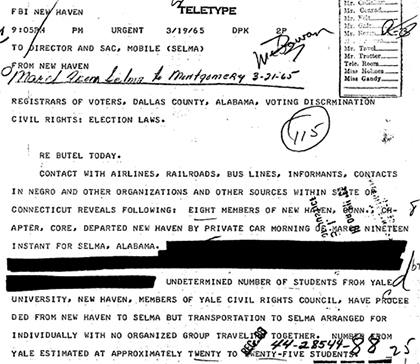
The FBI report on Yale people heading to Selma.
Most of those involved in Selma and Mississippi continued in related work, because those experiences changed our lives. I worked for the Child Development Group of Mississippi, a 39-county Head Start program, in the summer of 1965, and then worked during and after law school for the Office of Economic Opportunity until moving to Seattle in 1970. There I helped organize the statewide civil legal services program for low-income people in 1972 and have served on its and successor programs or fundraising boards since then. Others wound up in legal services too, including Steve Bingham ’64 and Dick Van Wagenen ’67, ’70 J.D. Jonathan Steele and Nicholas Bosanquet, Yale graduate students from England and undeniably “outside agitators,” returned home to work in journalism and public policy there. Joe Lieberman was in the October 1963 Mississippi group and went on to become a U.S. senator and vice-presidential candidate. Shel Stromquist ’66, the Yale Civil Rights Council chair after me, went on to teach labor history at the University of Iowa. Barrington D. Parker ’65, 69 LL.B., has had a distinguished career as a lawyer in private practice, leadership on the NAACP Legal Defense and Education Fund and as a trustee of Yale, and many years of public service as a jurist on the U.S. District Court and Court of Appeals.

